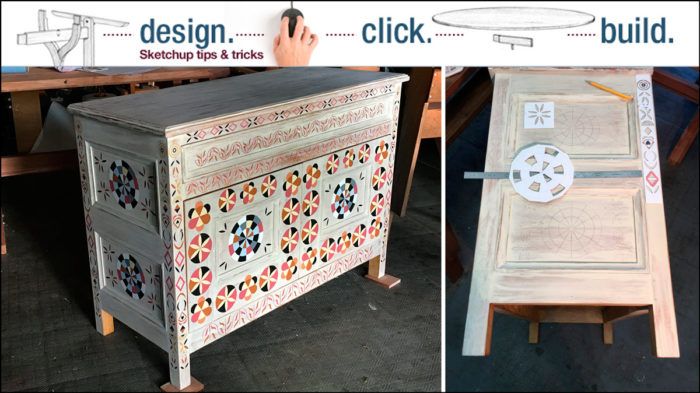A modern approach to an old artform
Tim Killen uses technology to duplicate a classic painted design from a Hadley chest
In reproducing furniture of the 17th and 18th C., I look forward to applying and experimenting with various traditional finishes – chemical & native plant dyes, linseed oil, shellac, milk paint, French polish, and beeswax. However, I’ve not done painted ornamentation as you would see in early blanket chests and some Hadley chests. For example, I ran across this chest built in 1695 in the Massachusetts-Connecticut Valley.

I decided to try this painted decoration on a new project, but not a “chest”. Rather I selected to reproduce a Low Cupboard from Tidewater VA, and then finish with the painted geometric shapes and stylish vines as shown on the above Hadley Chest. Here is the photo of the Tidewater VA Cupboard in the Colonial Williamsburg Collection.

I imported the above photo into SketchUp (as a Photo Match), and began capturing the component shapes and sizes. (My last blog entry showed how I do this Photo Match capability in SketchUp). Here is a rough capture of main component parts as displayed over the photo.

I continued working the details of the cupboard model in SketchUp as shown below.

This is a traditional post and panel construction as shown in this exploded view.

After modeling the cupboard, I used SketchUp to capture the geometric ornamentation on the Chest and apply to the Cupboard. As shown below, I traced over the geometric shapes using the Line, Arc, and Circle Tools. Then using the Colors provided in the Materials Dialog, I selected a combination of colors. I show this operation in the video at the end of this article.

I then copied and re-sized these colored geometric shapes, and applied them to the Cupboard Model, as shown below.

I constructed the cupboard in Monterey Pine, and chemically dyed to darken. Then sealed with shellac.

In SketchUp, I created the full size templates of the various geometric shapes, as shown below. These templates were used to outline the shapes on the cupboard components with pencil. These are not stencils, rather cut-outs to enable a penciled shape on the cupboard.


I obtained matching colors in acrylic at the local paint store, and began testing on one of the cupboard doors. At first I tried using oil colors purchased at the art store (knowing that the original painting on the chest would have been oil based). However, I found it difficult to match colors, and the oils took forever to dry. I also bought a set of art store brushes that were needed for this type of decoration.

I haven’t finished but it is getting close. I used local Monterey Pine for the construction.

Tim
@KillenWOOD
Fine Woodworking Recommended Products

Bahco 6-Inch Card Scraper

Blum Drawer Front Adjuster Marking Template



























Log in or create an account to post a comment.
Sign up Log in